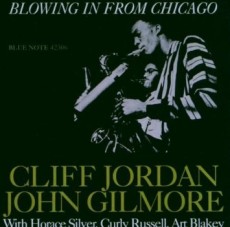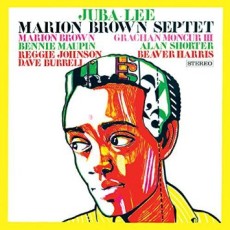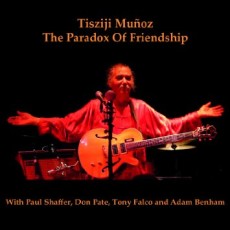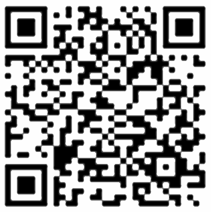
Daily Dose Of Jazz…
John Gilmore was born on September 28, 1931. Growing up in Chicago, Illinois he played clarinet from the age of 14 and took up the tenor saxophone while serving in the United States Air Force from 1948 to 1952. He then pursued a musical career, playing briefly with pianist Earl Hines before encountering Sun Ra in 1953.
For the next four decades, he recorded and performed almost exclusively with Sun Ra. This was puzzling to some, who noted Gilmore’s talent, and thought he could be a major star like John Coltrane or Sonny Rollins. Despite being five years older than Gilmore, Coltrane was impressed with his playing, and took informal lessons from him in the late 1950s. His epochal, proto-free jazz “Chasin’ the Trane” was inspired partly by Gilmore’s sound.
In 1957 he co-led with Clifford Jordan a hard bop Blue Note date Blowing In from Chicago with Horace Silver, Curly Russell and Art Blakey providing the rhythm section. In the mid-1960s John toured with the Jazz Messengers and participated in recording sessions with Paul Bley, Andrew Hill, Pete La Roca, McCoy Tyner, Freddie Hubbard, Elmo Hope, Phil Upchurch and others. By 1970 he was co-leading a recording with Jamaican trumpeter Dizzy Reece. Throughout his years of playing he mainly focused on the avant-garde with the Sun Ra Arkestra.
Gilmore’s devotion to Sun Ra was due, in part, to the latter’s use of harmony which he considered both unique and a logical extension of bebop. He occasionally doubled on drums and also played bass clarinet until Sun Ra hired Robert Cummings as a clarinet specialist in the mid-1950s. However, the tenor saxophonist made a huge contribution to Sun Ra’s recordings and was the Arkestra’s leading sideman, being given solos on almost every track on which he appeared.
John is known for his straight ahead post-bop running changes and fluency with a rhythmic and motive approach in addition to his long passages based exclusively on high-register squeals in the more abstract. His fame shrouded in the relative anonymity of Sun Ra’s Arkestra membership, his straight ahead post-bop talents are exemplified in his solo on the Arkestra’s rendition of “Blue Lou,” as seen on Mystery, Mr. Ra. Avant-garde tenor saxophonist John Gilmore led the Arkestra for a few years after SunRa’s death and up until his own of August 19, 1995.
More Posts: saxophone

Daily Dose Of Jazz…
Lisa Sokolov was born on September 24, 1954 in Manhasset, Long Island and raised in nearby Roslyn, New York. She was exposed to jazz as a child through her father, who played stride piano and listened to recordings of jazz artists including Art Tatum, Mabel Mercer and Stan Getz. She began singing from a young age and soon took up piano, which she studied for many years.
1972 saw Sokolov attending Bennington College in Vermont and studying with Milford Graves, Bill Dixon, Jimmy Lyons, voice teacher Frank Baker, and composers Vivian Fine and Louis Calabro. While there she was exposed to Betty Carter and Meredith Monk who have influenced her style. Obtaining a double major in music/back music, she became interested in free jazz as well as avant-garde jazz, both of which she has incorporated into her vocal style.
After graduation Lisa moved to New York City in 1976, spent several months in Paris, France, returned to pursue graduate work in music therapy, met Jeanne Lee and was subsequently introduced to bassist William Parker and a decade long collaboration was begun.
She was part of the Studio Henry scene, a cooperative performance space, alongsideJohn Zorn, Wayne Horvitz, Robin Holcomb, Elliot Sharpe and David Sewelson. The 1990s saw Sokolov recording music and releasing her debut as a leader, angel Rodeo, followed by her second release six years later in 1999 titled Lazy Afternoon. She has since released five more albums.
As an educator Sokolov has worked as a music therapist, has taught in NYU’s graduate music department and is currently a full arts professor at the Experimental Theater Wing at the Tisch School of the Arts, which is part of New York University, and is recognized in the music therapy world as a pioneer and innovator in the applications of the voice to human potential.
She has worked with Cecil Taylor, William Parker, Robin Holcomb, Rahn Burton, Rashid Ali, Bada Roy, Jeanne Lee, Jimmy Lyons, Wayne Hovitz, Hilton Ruiz, Irene Schweizer, Butch Morris, Blue Gene Tyranny, Jim Mc Neely, Gerry Hemingway and Cameron Brown to name a few. A courageous and adventurous vocalist, Lisa Sokolov continued to sing, compose and perform.

Daily Dose Of Jazz…
Marion Brown was born on September 8, 1931 in Atlanta, Georgia. He joined the Army in 1953 and three years later attended Clark College to study music. By 1960 he left Atlanta for pre-law at Howard University but after two years moved to New York City and befriended Amiri Baraka, Ornette Coleman, Archie Shepp, Sun Ra, Pharoah Sanders, Paul Bley, Clifford Thornton and Rashied Ali. During this early Sixties period he recorded several important albums such as Archie Shepp’s Fire Music and New Wave In Jazz, and most notably on John Coltrane’s Ascension.
1967 saw Brown in Paris, France where he developed an interest in architecture, impressionist art, African music and the music of Eric Satie. He became an American Fellow in Music Composition and Performance at the Cite International Des Artists in Paris, composed the soundtrack for Marcel Camus’ film Le Temps fou, a soundtrack featuring Steve McCall, Barre Phillips, Ambrose Jackson and Gunter Hall.
Returning to the US in 1970 he landed in New Haven, Connecticut taking a position as a resource teacher in a child study center in the city’s public school system for a year. He went on to be an assistant professor of music at Bowdoin College, and through the 70s joined the faculties of Brandeis University, Colby College, Amherst College and Wesleyan University, earning a Masters in ethnomusicology at the latter.
Throughout his many educational positions, Brown continued to compose and perform, lending his alto saxophone to the recording of Harold Budd’s The Pavilion of Dreams. He received grants from the National Endowment for the Arts, composing and publishing several pieces for solo piano. In 1981, he ventured into drawing and painting and his charcoal portrait of blues guitarist Blind Lemon Jefferson was included in a New York City Kenkeleba Gallery art show called Jus’ Jass, alongside Romare Bearden, Charles Searles and Joe Overstreet.
By the 2000s, avant-garde alto saxophonist Marion Brown had fallen ill due to a series of surgeries and a partial leg amputation. For a time he was in a New York nursing home but in 2005 he moved to an assisted living facility in Hollywood, Florida. He left a catalogue of twenty-five albums as a leader and several more as a sideman before he passed away on October 18, 2010 at age 79.
More Posts: saxophone

Daily Dose Of Jazz…
Mike Davis was born on August 9, 1972 in Rosenberg, Texas not far from Houston. Mike grew up in a small Texas town not far outside of Houston called Rosenberg. Though music was in his blood from a very early age, he didn’t begin seriously playing an instrument until around age 14. His began with the bass and soon was playing in his high school big band as well as in the Symphonic band. He borrowed other instruments from the school and began to practice and experiment with clarinet, trombone, trumpet, French horn, drums and piano. Ultimately the bass was his best fit as he discovered his first great jazz album – Chick Corea’s ‘Now He Sings-Now He Sobs’.
Davis studied bass, theory and jazz with Dave Foster, Eric Late, Shelly Berg and Bruce Dudley. He played gigs in Houston with his first influential peers – Todd Harrison, Mike Wheeler, Harry Shepard, Joe LoCascio, Tony Campisi, Woody Witt, Clark Erickson, Ted Wenglisnski. In 1993 Mike began studying jazz, classical bass, arranging, composition, improvisation, table and North Indian classical music. During this time Mike performed regularly with Dave Zoller, Pete Peterson and the Collection Jazz Orchestra, Allison Wedding, Pablo Mayor and many others. He was a regular member of the bands Little Jack Melody and his Young Turks, Sol Caribe and The Great Escape. Mike also formed his original avant-garde ensemble Sand with guitarist Niclas Höglind, saxophonist Jacob Duncan and drummer Chris Michael.
In 1998 Mike moved to New York City and focused on jazz performance playing with the likes of Lynne Arriale and Steve Davis, Cheryl Pyle, Tom Chang, Rez Abbasi, Dave Phelps, the SoHa Big Band, Jonathan Kreisberg, Dave Wood, Billy Eric and Mike Freeman. He moved into the pop rock and folk genres as a producer, editor and mixer but eventually returned to his own creative endeavors. Launching Tmpf Records he released three albums, I See Better With My Eyes Closed, It Won’t Get Dark and Fortunes and Hat-tricks, Vol. 1, as a leader of a quartet, duo and trio respectively.
Over the years bassist Mike Davis has perform and recorded with Airto Moreira, Norah Jones, Steve Gadd, Ed Thigpen, Doc Cheatham, Bobby Womack, Ellen Greene, Peter Erskine and Poncho Sanchez to name a few. He continues to compose, perform, collaborate and record.
More Posts: bass

Daily Dose Of Jazz…
Tisziji Muñoz was born July 15, 1946 in Brooklyn, New York. He learned to play guitar as a child using a single-line playing style, due to a childhood wrist injury. Spirit-taught, the avant-garde jazz virtuoso and extreme guitarist is best known for his uniquely original guitar sound and playing style, likened to that of a spiritual tornado.
Tisziji became interested in jazz in 1968 when he was introduced to the music of John Coltrane while enlisted in the US Army 440th General’s Band. Upon discharge he pursued his musical interests in Canada and took a lead role in the development of Toronto’s underground music scene, where he began a long lasting working relationship with pianist Paul Shaffer and performed as guitarist in the musicals Hair and Godspell.
In the mid-70’s, Muñoz returned to New York City and began collaborating and performing with saxophonist Pharoah Sanders followed by projects and releases with Ravi Coltrane, Dave Liebman, Marilyn Crispell, Paul Shaffer, Steve Kuhn, Lam Sobo John Medeski, Bernie Senensky, Chris Caswell, Henry Kaiser, Ra Kalam Bob Moses, Don Pate, John Lockwood, David Finck and the late greats Rashied Ali, Lew Soloff, John Hicks, Nick Brignola and Hilton Ruiz.
Tisziji has performed at the Montreal Jazz Festival, appeared on The late Show with David Letterman, played Carnegie Hall, The Village Vanguard and Gate, Iridium, Dizzy Club coca Cola and Jazz at Lincoln Center among other venues.
An accomplished author, Tisziji has independently published numerous written works encompassing his own Heart-Fire Sound realization and embracing the subjects of spirituality, genius, creativity and time mastery. His books and music have radically transformed the manner in which musicians think and play music, validating the spirit of the genuine creative artist – from the inside out. Avant-garde jazz guitarist continues to compose, record and perform.
More Posts: guitar


